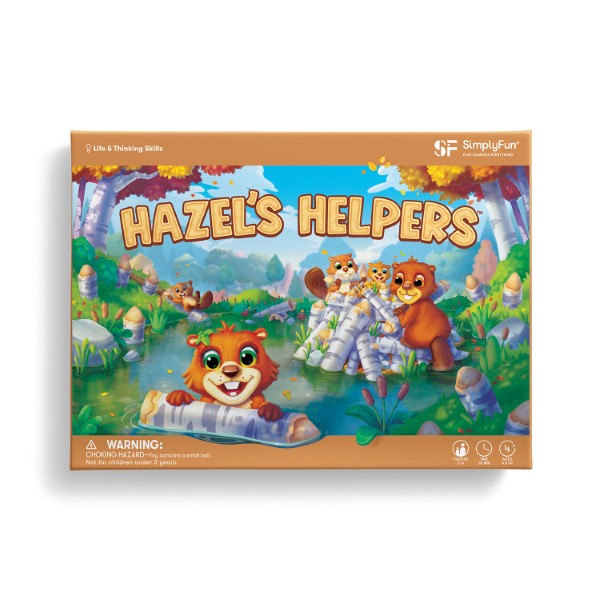
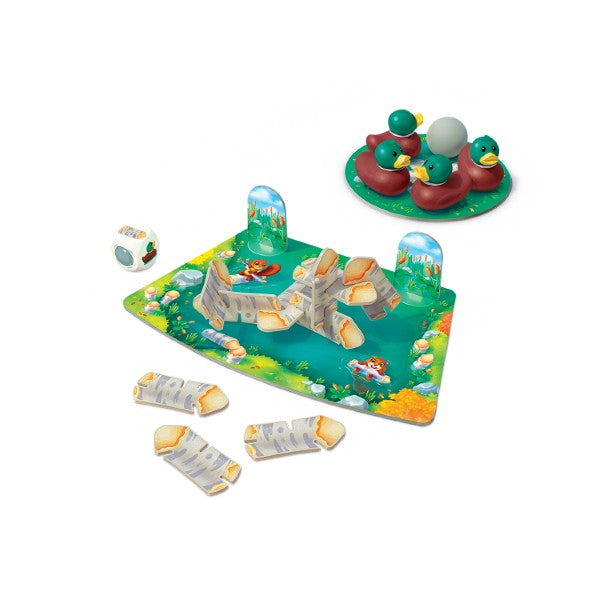
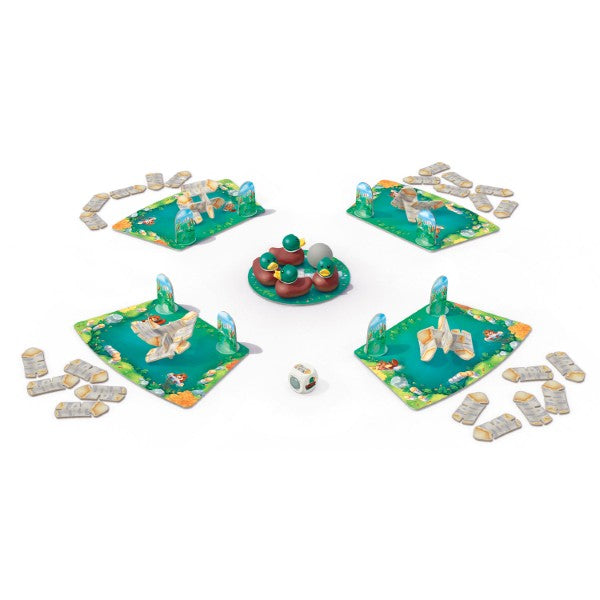
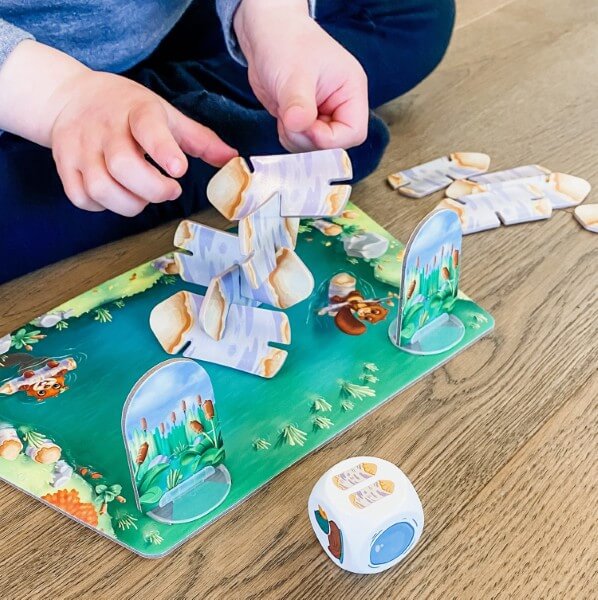
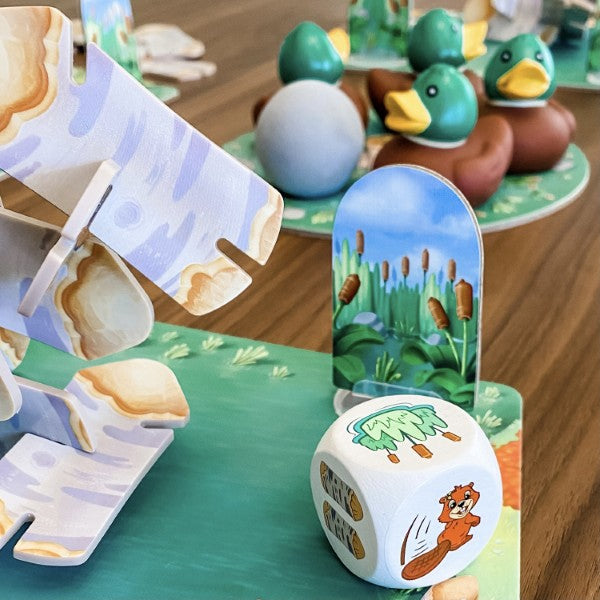
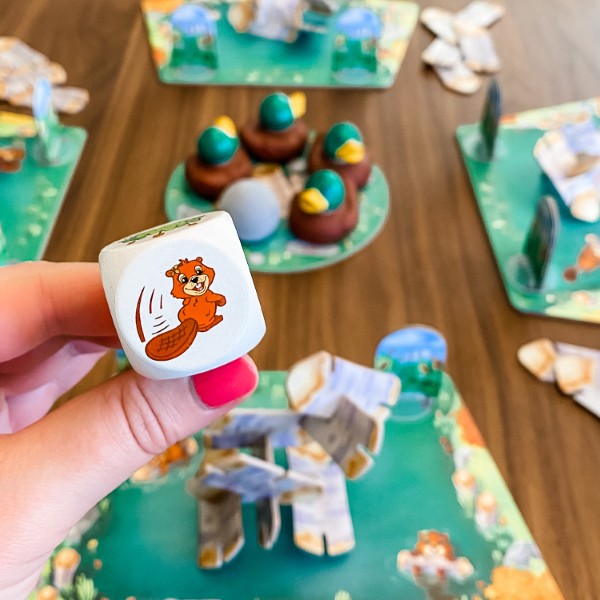
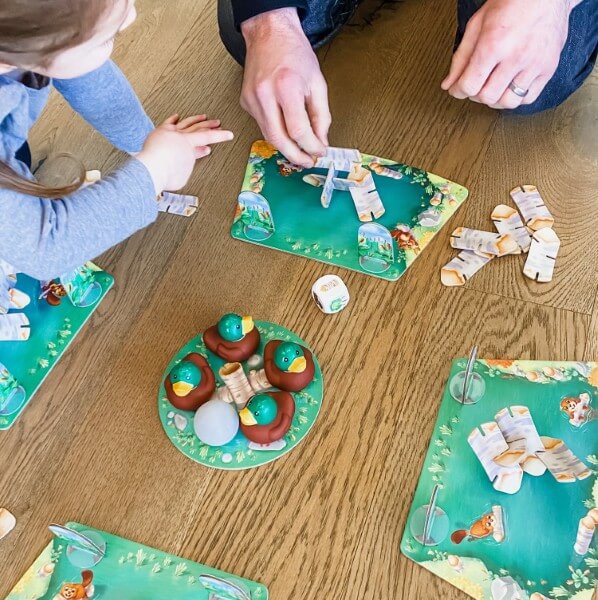
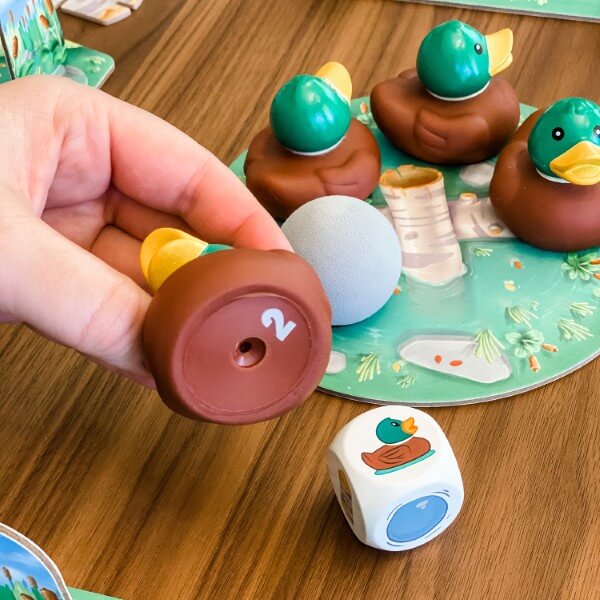


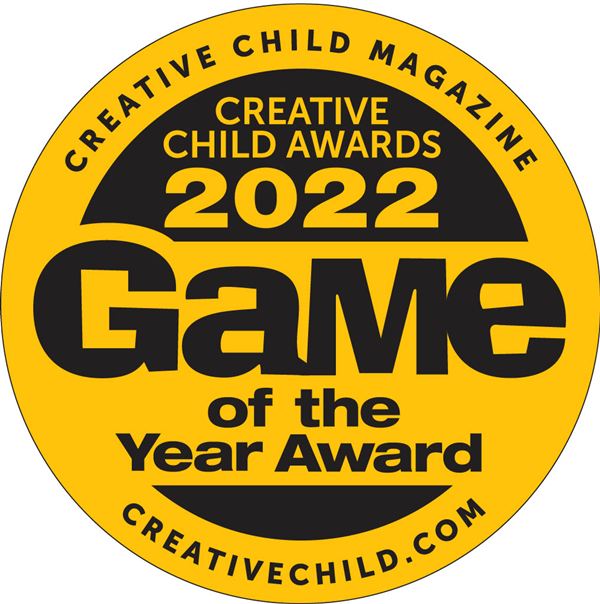
Collapsible content
A fun filled game where players join Hazel and her siblings in the pond as they practice their beaver lodge building skills.
You can play Hazel’s Helpers with 2-4 players, ages 4 and up.
Hazel’s Helpers is good for developing Fine Motor Skills, as players connect individual log pieces to build unique structures and roll a rock, trying to avoid the cattail blockers on another player’s board.
Hazel’s Helpers also helps with Decision Making. Players learn to consider the benefits or risks while making decisions such as how to connect their log pieces, which duck to choose and which player’s board to roll the rock towards.
Each player chooses a player board and places it in front of themselves with the open slots of the board facing the center of the play area.
Give 10 log pieces to each player to place in a pile next to their boards. Any remaining logs go back in the storage bag.
Each player receives two cattail pawns. Insert them into the open slots in the front corner spaces of your board.
Place the round center board in the middle of the play area, where everyone can reach it.
Put the rolling rock in the cut-out area of the center board. This will help keep it from rolling away.
Then place all the ducks on the center board. Mixing them up so players do not know which number duck is placed where.
The youngest player goes first and takes the die.
Players take turns rolling the die. Based on the roll, they will either connect logs to build a beaver lodge, interact with the ducks, remove or replace cattails, or roll the rock. The first player to use all 10 of their logs to build a beaver lodge wins the game!
On your turn, roll the die and take one of the following actions:
One or Two Logs
When you roll a log symbol, add the number of logs shown on the die from your pile to create your beaver lodge.
Use any of the slots in the logs to slide them together.
The logs can be assembled slot to slot, or slot to any location on a log piece. Logs can connect to each other in any way as long as the pieces do not go beyond the edges of your board.
If the first log you add is a single log, place it on your board and wait to connect it the next time you can add a log. This ends your turn.
Duck
Everyone says, “Quack, Quack” to share how happy the ducks are in their new pond.
Then ALL players at the same time pick ANY duck from the center board.
Turn over the duck to find the number 1 or 2 on the bottom. This number tells you how many logs to add to your lodge.
After everyone adds their logs, players return their ducks to the center board. Then the player that rolled the die rearranges the ducks to mix up the numbers for the next time. This ends your turn.
Cattail
The cattails help players protect their lodge from potential hazards found in the pond.
Each time you roll the cattail symbol, remove a cattail pawn from your board and place it to the side.
In future turns, if both cattails have been removed, you may now add one cattail back to your board when this symbol is rolled. Insert the cattail pawn back into one of the front corners of your board. This ends your turn.
Rolling Rock
All the splashing in the pond has stirred up the water and a rock has gotten loose. The player that rolled the rock symbol takes the rock and rolls it on the table or play area toward the front of another player’s board, trying to hit their beaver lodge. Rocks should only be rolled and not thrown.
Before rolling the rock, the player may move where they are situated at the table or play area, so they are positioned directly across from the player whose board they are rolling the rock toward.
Players may also slide the center board and ducks out of the way before rolling, and then return them to the middle of the play area after the roll is completed.
If the rock hits any part of the opponent’s lodge, they will need to remove any one log from their lodge and return it to their log pile.
If the rock hits a cattail pawn on their board, their lodge is safe, and the cattail pawn stays in place.
After a roll, the rock is returned to the center board.
This ends your turn.
Tail Slap
A beaver slaps their wide, flat tail on the surface of the water to warn others of possible danger nearby. As a reward for warning your family and the other animals, you can roll again.
When you roll the tail slap symbol, ALL players clap their hands to make the sound of a tail slapping the water.
The player that rolled the tail slap then rerolls the die and performs the action of the new symbol.
If you roll the tail slap again, continue rolling until another symbol appears.
After completing an action, play continues to the left and the next player rolls the die.
The first player to use all 10 of their logs to build a beaver lodge wins the game.
Join Hazel and practice your building skills as you explore all the creative ways you can connect the logs to build your beaver lodge before the other players complete their lodges with Hazel’s Helpers!


Core Standard*: Math
Math
- Counting and Cardinality
- Know number names and the count sequence: Grade Level K
- Count to tell the number of objects. Grade Level K
- Measurement & Data
- Classify objects and count the number of objects in each category. Grade Level K

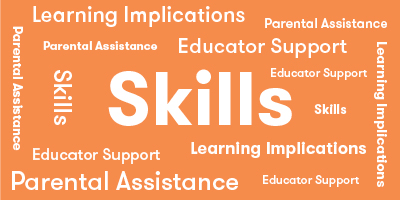
Explore
What Does Child Do To Use Skill In The Game?
Players will examine and think about how logs can go together to create a lodge. They also look closely at other players' boards to decide where to roll the rock.
How Parents Can Assist Learning
Children likely do not need parental support to play Hazel's Helpers. If you notice a child's attention wandering away from the game, gently encourage them to pay attention to the roll of the die because at any moment the duck or the beaver can come up and everyone gets to participate!
Learning Implications and Educator Support
Hazel's Helpers is a good game for sensory motor exploration and development along with spatial reasoning. Building the lodge requires fine motor dexterity as children examine their lodges in order to decide where to connect more logs.
Rolling the rock allows for children to learn about directionality, applying force, the effects of different levels of force, and the different physical motions that can be used to successfully hit another player's lodge with the rock.
Determine
What Does Child Do To Use Skill In The Game?
Players make many decisions during the game such as how to lock logs together, whether to build their lodge more vertical or horizontal, which cattail to remove or replace, and how and where to roll the rock.
How Parents Can Assist Learning
Children likely do not need parental support to play Hazel's Helpers. If you notice a child is having difficulty making a decision, encourage them to go ahead and try an option they are considering. Then, see what happens. This will allow them to learn what works well and what may not work as well.
Learning Implications and Educator Support
Hazel's Helpers is a good game for sensory motor exploration and development along with spatial reasoning. Building the lodge requires fine motor dexterity as children examine their lodges in order to decide where to connect more logs.
Making decisions on how to roll the rock allows for children to learn about directionality, applying force, the effects of different levels of force, and the different physical motions that can be used to successfully hit another player's lodge with the rock.
Compare
What Does Child Do To Use Skill In The Game?
Players will look at and compare the lodges and cattails on the boards of other players in order to determine toward which to roll the rock.
How Parents Can Assist Learning
If a child is having a hard time deciding where to roll their rock, try asking questions like, "Who has build the biggest lodge?" or "Which lodge does not have a cattail in front of it?" You can also encourage the child to stand up and walk around to get a different visual perspective of the other players' board, which could help make it clearer which lodge would be easiest to hit with the rock.
Learning Implications and Educator Support
Hazel's Helpers helps children develop analytical and reasoning skills as they examine and compare the boards of other players in order to decide where to roll the rock.
If a child is having a hard time deciding where to roll their rock, try asking questions like, "Who has build the biggest lodge?" or "Which lodge does not have a cattail in front of it?" You can also encourage the child to stand up and walk around to get a different visual perspective of the other players' board, which could help make it clearer which lodge would be easiest to hit with the rock.
Plan
What Does Child Do To Use Skill In The Game?
While there is not much planning in Hazel's Helpers, players do need quickly assess where and how to roll the rock. They also think about and connect logs together to build their lodge horizontally or vertically.
How Parents Can Assist Learning
Parent can enhance the planning aspects of the game by asking children to declare where they want the rock to hit and describe how their "rolling" technique will help them be successful. Similarly, they can encourage children to build more horizontally during one game, and then vertically another time.
Learning Implications and Educator Support
Hazel's Helpers is good for developing motor planning. Educators can enhance the planning aspects of the game by asking children to declare where they want the rock to hit and describe how their "rolling" technique will help them be successful.
Experiment
What Does Child Do To Use Skill In The Game?
Player may experiment with building their lodge more horizontally or vertically. They may also try different ways to roll the rock to see what is most accurate.
How Parents Can Assist Learning
Parents may want to encourage children to try different ways to build their lodges. Sometimes build more vertically and other times more horizontally. Also, encourage children to build them on different areas of their board.
If you notice a child is having difficulty "rolling" the rock successfully, show them one or two other ways they may try to roll the rock.
Learning Implications and Educator Support
Hazel's Helpers allows children to try different ways to build a lodge or roll their rock, which in turn is a good way to learn about the cause and effect of decisions.
Educators may want to encourage children to try different ways to build their lodges. Sometimes build more vertically and other times more horizontally. Also, encourage children to build them on different areas of their board.
If you notice a child is having difficulty "rolling" the rock successfully, show them one or two other ways they may try to roll the rock.
Practice
What Does Child Do To Use Skill In The Game?
The more players roll the rock, the more proficient they will become in later turns or game play.
How Parents Can Assist Learning
If you notice a child is having difficulty "rolling" the rock successfully, show them one or two other ways they may try to roll the rock.
Learning Implications and Educator Support
This is a good game for developing hand-eye coordination. If you notice a child is having difficulty "rolling" the rock successfully, show them one or two other ways they may try to roll the rock.
*Data compiled from CCSSI ELA Standards, WA Science Standards, and Washington Social Studies Standards

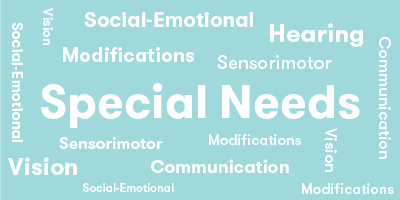
Cognitive
Suggestions for How to Modify Play Experience
Hazel's Helpers is very concrete and visual with many manipulatives, so it will be motivating to children who may have cognitive challenges. Children may need to be reminded of what action each side of the die represents. If a prompt is needed, other players can tell the child what to do or model the actions needed. The numbers 1 and 2 are the only written numbers in the game. If the child doesn't recognize the numbers, another player can hold up one or two fingers to show the child how many logs they can take.
Use fewer logs for each player in the game if the child has difficulty counting to 10. Many children may be able to count to 5, so using 5 logs may enable the child to count them and will also reduce the time of play for each round.
Communication
Suggestions for How to Modify Play Experience
Minimal language is required in Hazel's Helpers. Players need to quack or slap hands and indicate how many logs they can take, although this could be done with fingers or by just showing the die or duck.
To encourage conversation, have a discussion prior to the game about the functions of the cattails and how they can protect the dam. Players can also talk about whether the cattails protected their dam when another player rolled the rock toward their dam. This may lead to a discussion about where to build the dam or in what direction to build it, i.e. vertical or horizontal.
To encourage communication, ask each player to name what is on the die when they roll it. Also encourage conversation by asking open-ended questions like "What do you think will happen when you roll the rock?" or "How did you feel when you knocked down his dam?"
Sensorimotor
Suggestions for How to Modify Play Experience
Hazel's Helpers requires fine motor skills to put together the logs. Eye-hand coordination is also needed for rolling the rock toward a dam. If children have problems with fine motor or visual motor control, Hazels Helper's may be too challenging.
If their fine motor problems are mild, Hazel's Helpers may be good practice for developing more refined skills. Putting together logs and aiming the rock requires focused attention on fine motor skills.
If the child has difficulty with eye hand coordination, allow them to remove the ducks from the center board and use the placement hole for the rock as a "launch pad" for pushing the rock toward the targeted dam. This will help them aim from a shorter distance and have more control over their aim.
To give the child some parameters for pushing the rock, place a string between the rock and the dam as a guide to help the child's aim.
Social Emotional/Behavioral
Suggestions for How to Modify Play Experience
Children may get frustrated if they only get "1's" when rolling the die or picking a ducks. Watching others win may be frustrating. Allow them to keep their protective cattails, which my help them keep their dam intact. Point out when other get 1's as well and say something like "Everyone has bad luck sometimes."
Encourage positive comments when others make a good play or add to their dam. Refer to the story of how Hazel is helped by her brothers and sisters as a model for play. Discuss how cheering for others makes everyone feel good about themselves.
Use exaggerated noises (quacking and clapping) to keep energy high. Being silly can help children have more fun in the game.
Vision
Suggestions for How to Modify Play Experience
Players need to be able to see the dice to know what to do and other players boards when they need to roll the rock toward the other player's dam. Also, the slots on the logs may be difficult for some children to see. Although some children may be able to use touch to find the slots and put them together, the other visual requirements of the game may make Hazel's Helpers too challenging for players with low vision or blindness.
Hearing
Suggestions for How to Modify Play Experience
The player who is deaf or hard of hearing can show other players the die face that rolls up, so other players see what the player needs to do. Communication is not needed to play, but having players sign or gesture will add fun to the game.
*Data compiled from CCSSI ELA Standards, WA Science Standards, and Washington Social Studies Standards

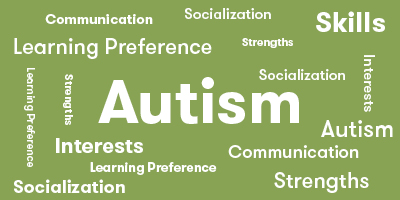
Autism Strengths & Interests
Short Summary of Strengths & Interests
- Fine motor skills
- Eye-hand coordination
- Decision making
Is good at matching visual items
Is This Game Appropriate? Yes
Description
Players have to match the number of logs on the die to the logs in their pile.
Has a good memory for sensory details, including visual, touch, taste and smell
This game is not appropriate
Has a good memory for words, phrases and dialouge
This game is not appropriate
Has a good memory for pictures, numbers and patterns
This game is not appropriate
Likes to put things in order or a sequence
This game is not appropriate
Learns through visualizing or "replaying" actions in their mind
This game is not appropriate
Likes activities with rules, such as math and phonics
This game is not appropriate
Is very concrete and literal
Is This Game Appropriate? Yes
Description
The game involves understanding what the symbols on the die stand for and what actions are associated with each side. It also involves putting logs together by manipulating and orienting slots.
Learns in small "chunks" (for example, phone numbers are 3 chunks of number xxx-xxx-xxxx that are combined together)
This game is not appropriate
Is good at nonverbal reasoning and logic
Is This Game Appropriate? Yes
Description
Strategy is involved in deciding which duck to select, which players' dam to roll the rock toward, and where to place their logs. These actions involve nonverbal reasoning.
Likes spatial problem solving
Is This Game Appropriate? Yes
Description
Players need to decide where to place logs to make their dam stable and harder to hit. They also need to aim the "rock" correctly to hit another player's dam. Both of these require spatial reasoning. Especially as the dam grows larger, players need to think about how to position their logs for stability and so they won't get hit by the rock. Players also need to keep their dam within the confines of their board, keeping their dam within spatial parameters.
Can read well with good vocabulary, though may not fully comprehend content
This game is not appropriate
Likes to use and has good fine motor skill
Is This Game Appropriate? Yes
Description
Fine motor skills are a key aspect of Hazel's Helpers. Children need to use their fingers to combine the log slots and to aim and roll the "rock."
Likes established routines or set ways of doing things
Is This Game Appropriate? Yes
Description
The game involves understanding what the symbols on the die stand for and what actions are associated with each side. Once these are understood the game follows the same sequence of play with each round. Although the dam may vary with each round of play, the same actions are used. This game is not appropriate
Likes manipulating, constructing or building things
Is This Game Appropriate? Yes
Description
The goal of the game is to build a dam with all 10 logs in your pile. This requires investigation of where the slots are, orienting the logs, and pressing them together. As the dam grows, players have to look for the best options for adding new logs. Players also like throwing the die and determining the associated action.
Likes to use and has good musical abilities
This game is not appropriate
Likes to use and has good drawing skills
This game is not appropriate
Autism Special Considerations
Appears to ignore other's communication and/or has difficulty giving eye contact to a communication partner
Is This Game Appropriate for Child with Characteristic? Yes
Can Child with Characteristic Play Game w/o Modification? Yes
Strategies for Developing Compensatory Skills:
Hazel's Helpers does not require eye contact to play, players can look at the die, cattails, ducks, logs, and the boards. Players do need to name the letter and the picture under the letter on the letter boards, but additional communication is not needed.
Has difficulty understanding complex verbal directions
Is This Game Appropriate for Child with Characteristic? Yes
Can Child with Characteristic Play Game w/o Modification? Yes
Strategies for Developing Compensatory Skills:
The directions for Hazel's Helpers are not difficult to understand. Some children may need prompting to remember what each symbol on the die represents.
Uses vocabulary inaccurately or demonstrates echolalia (repeating another's speech)
Is This Game Appropriate for Child with Characteristic? Yes
Can Child with Characteristic Play Game w/o Modification? Yes
Strategies for Developing Compensatory Skills:
Echolalia should not interfere with the game unless it is extreme. In this case provide fidget toys as a distractor.
Gets stuck repeating a verbal topic or physical actions and/or has difficulty attending to others' actions or topic.
Is This Game Appropriate for Child with Characteristic? Yes
Can Child with Characteristic Play Game w/o Modification? No
Strategies for Developing Compensatory Skills:
Give the child visual cues to help them watch other players actions. For example, put a toy next to the player who is taking a turn. Use fidget toys and give activity breaks as needed.
Has difficulty producing speech/communication
Is This Game Appropriate for Child with Characteristic? Yes
Can Child with Characteristic Play Game w/o Modification? Yes
Strategies for Developing Compensatory Skills:
Players do not need to communicate verbally. They can show the die or use gestures or actions to illustrate what they are doing.
Has difficulty sequencing multi-step actions and/or doing complex abstract tasks
Is This Game Appropriate for Child with Characteristic? Yes
Can Child with Characteristic Play Game w/o Modification? No
Strategies for Developing Compensatory Skills:
Other players can prompt the child verbally or with gestures if they need assistance remember what the next step is in play
Demonstrates difficulty initiating and maintaining social interactions
Is This Game Appropriate for Child with Characteristic? Yes
Can Child with Characteristic Play Game w/o Modification? Yes
Strategies for Developing Compensatory Skills:
The child may need help the remember to take turns with other players. Use verbal prompts or a visual prompt such as holding up the die before the child to indicate it is their turn.
Acts out or demonstrates avoidance behaviors when frustrated, overwhelmed, or needs more sensory input.
Is This Game Appropriate for Child with Characteristic? Yes
Can Child with Characteristic Play Game w/o Modification? Yes
Strategies for Developing Compensatory Skills:
Allow time between turns for movement and use fidget toys as needed. Also, assist the child when rolling the rock.
Has short attention span for non-preferred activities
Is This Game Appropriate for Child with Characteristic? No
Can Child with Characteristic Play Game w/o Modification? No
Strategies for Developing Compensatory Skills:
If the child does not like building with small items or performing a sequence of tasks in a row, Hazel's Helpers may not be a good match for the child.
Needs sameness or consistent routines and/or has difficulty with transitions from one activity to another
Is This Game Appropriate for Child with Characteristic? Yes
Can Child with Characteristic Play Game w/o Modification? Yes
Strategies for Developing Compensatory Skills:
The sequence of play is consistent for each turn, but the dam structures and number of logs earned on each turn will vary.
Has difficulty understanding others' feelings, intentions, and the reasons for others' actions.
Is This Game Appropriate for Child with Characteristic? Yes
Can Child with Characteristic Play Game w/o Modification? Yes
Strategies for Developing Compensatory Skills:
Although getting your dam hit may elicit some negative feelings, this presents an opportunity to discuss their own and others' feelings.
*Data compiled from CCSSI ELA Standards, WA Science Standards, and Washington Social Studies Standards


Extra Ways to Play the Game
When logs are rolled on the die the player has the option of adding to his own dam or taking from another player.
Materials Needed
No additional materials are needed.
Developmental Benefits
Giving players the option for taking logs from another player or adding to his own dam introduce the idea of strategy to the young child. This also encourages the child to look at whose dam has the most logs and compare amounts.
Extra Ways to Play the Game
When the duck is rolled on the die, the player rolling the die gets to pick a duck for each player.
Materials Needed
No additional materials are needed.
Developmental Benefits
Handing out the ducks allows the player who rolled the die face with a duck to make strategic decisions about who gets a one or a two. This encourages players to keep track of the amount of logs on each player's dam.
Extra Ways to Play the Game
Play so all players need to build vertically.
Materials Needed
No additional materials are needed.
Developmental Benefits
Building vertically will help players learn about balance and symmetry. A vertical dam will also make the dam harder to hit with the rock.
Extra Ways to Play the Game
Play with partners with one board for the pair and 15 logs.
Materials Needed
No additional materials are needed.
Developmental Benefits
Playing with a partner requires discussion of where to place the logs in the dam structure so that it is harder to hit or sturdier.
Extra Ways to Play the Game
In this variation, each player needs to make 2 lodges with 5 logs each. Additionally, the cattails are treated slightly differently. When the game starts, a player has 2 cattails on their board. If the roll a cattail, they remove one. When the roll cattail again, they remove the other. The third and forth times, they add a cattail so that they end up with 2 cattails on their board again. Then, the process starts over. Thus, if they roll a cattail for the fifth time, one cattail is removed and so on.
Materials Needed
No additional materials are needed.
Developmental Benefits
Building 2 lodges adds variety, and therefore, increases the strategic thinking of the game.
*Data compiled from CCSSI ELA Standards, WA Science Standards, and Washington Social Studies Standards
Game Details
- 40 Logs
- 4 Player Boards
- 8 Cattail Pawns
- 1 Center Board
- 4 Ducks
- 1 Rolling Rock
- 1 Die
- 1 Storage Bag
- 1 Rules Booklet
- Choosing a selection results in a full page refresh.
- Opens in a new window.













